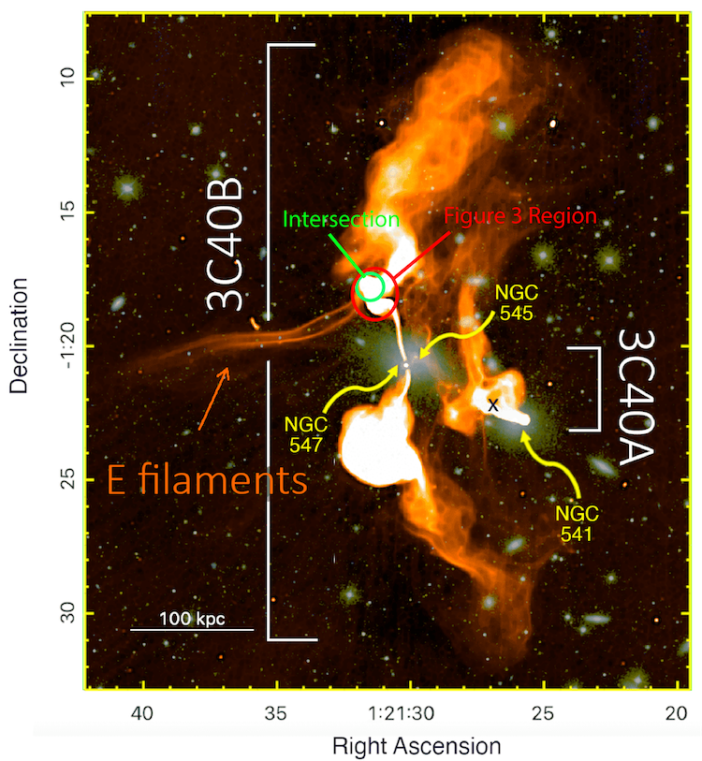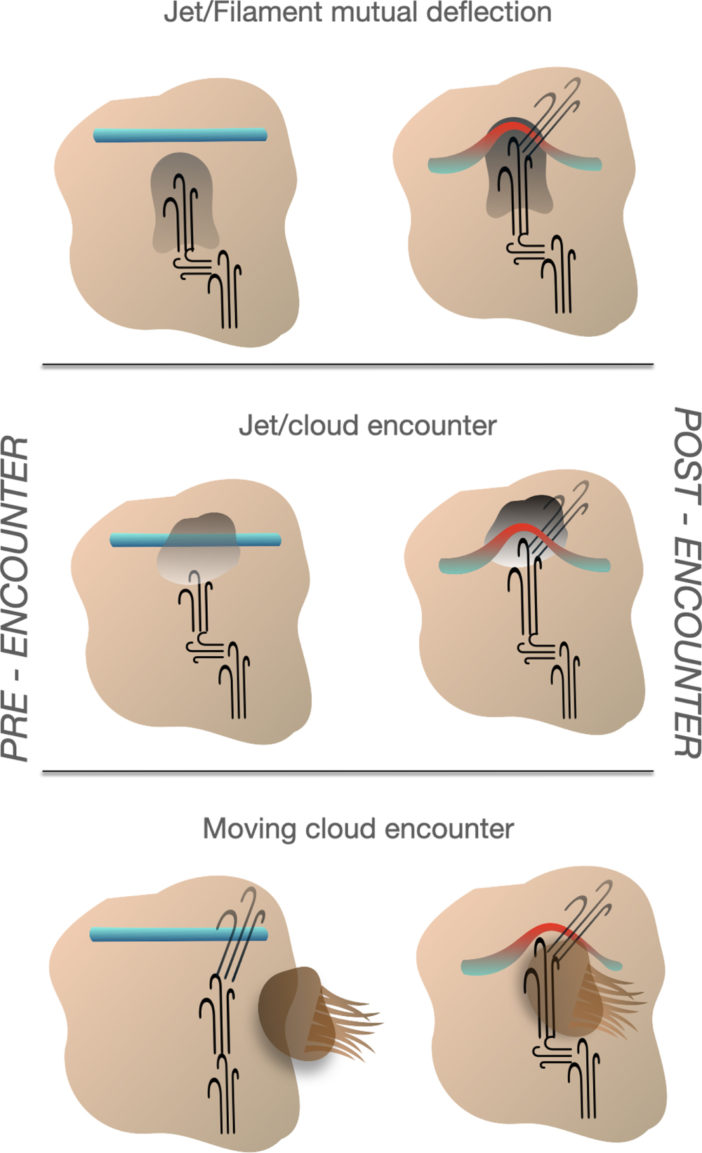Editor’s Note: Astrobites is a graduate-student-run organization that digests astrophysical literature for undergraduate students. As part of the partnership between the AAS and astrobites, we occasionally repost astrobites content here at AAS Nova. We hope you enjoy this post from astrobites; the original can be viewed at astrobites.org.
Title: Intracluster Magnetic Filaments and an Encounter with a Radio Jet
Authors: L. Rudnick et al.
First Author’s Institution: University of Minnesota
Status: Published in ApJ
The intracluster medium is wracked with the battle scars left behind over the history of a galaxy cluster: cavities, shocks, sound waves, and radio lobes. The blast zones of relativistic jets and the fronts left behind by the imperial ambitions of galaxies are etched onto the intergalactic landscape. But there is an order to this chaos. Out of the fog, long and slender networks of filaments coalesce, lit up by flows of charged particles like neurons of a vast cosmic brain.

Figure 1: Filtered radio image of the galaxy cluster Abell 194, showcasing the many magnetic filaments embedded in its plasma. [Rudnick et al. 2022]
One such galaxy cluster, the cluster Abell 194, is shown in Figure 1. Today’s article uses radio and X-ray observations to map out a particular subset of the cluster’s filaments and their interactions with a supermassive black hole’s fury.
A Cluster Wracked by Extremes
Abell 194 is a galaxy cluster containing a pair of interacting galaxies, 3C40A (aka NGC 541) and 3C40B (aka NGC 547), shown in Figure 2. As the two galaxies draw closer together under their mutual gravity, gas is dislodged from its usual orbits, spiraling into the waiting maws of their supermassive black holes. The resulting jets billow out across millions of light-years, radio waves whispering of powers terrible and gross. The two galaxies’ violent ejections have a huge impact on their surroundings, filling the cluster with cosmic rays and triggering a starburst where 3C404A’s jet collides with another galaxy. The jets’ impact is also felt in the intricate web of magnetic filaments threading through the galaxy cluster. Two 650,000-light-year-long strands in the east, nicknamed the E filaments (see Figure 2), are warped by the jet from NGC 3C40B. The authors decide these filaments deserve further investigation.

Figure 2: Radio-emission map showing the locations of 3C40A/NGC541, 3C40B/NGC 547, their twisted jets, and the eastern filaments (E filaments) trailing away from 3C40B’s jet. The region where the E filaments intersect 3C40B’s jet is marked with a green circle. The larger region of interaction considered in Figure 3 is marked with a red ellipse. Note how the E filaments and the jet bend where they encounter each other. 100 kiloparsecs (kpc) is about 320,000 light-years. [Adapted from Rudnick et al. 2022]
Following the Field Lines
Radio waves are just a long kind of light waves, so they have electric fields that oscillate. The direction in which the electric fields point while they oscillate is called the polarization of the wave. As the wave travels through a magnetized plasma, its electric field (and hence polarization) rotates. This is known as Faraday rotation. The amount of rotation depends on the magnetic field strength along the line of sight, so the polarization of radio waves can be used to map out the structure of magnetic fields. The authors take great advantage of this effect. They find that the E filaments have a field strength of around 1.4 x 10-10 Tesla (for comparison, Earth’s magnetic field is 3.05 x 10-5 Tesla). The field is oriented vertically at the intersection between the E filaments and 3C40B’s jet, but the field rotates to nearly horizontal farther along the filaments’ length. While bright in radio, the filaments are faint in X-rays, suggesting the fields are strong enough to block the flow of the hotter (X-ray emitting) plasma in the cluster.
But are the fields strong enough to impede 3C40B’s jet? The jet bends where it intersects the E filaments, the frothing rage of a supermassive black hole seemingly blunted by flimsy filaments. However, the authors note the jet is supersonic and, in this case, should be able to pass through the filaments without being deflected. Some other reason for the jet’s bending must be found. Another scenario (shown as the middle row in Figure 3) is that the magnetic filaments are embedded in a dense cloud. The jet pushes the cloud aside as it strikes, and the cloud drags the filaments along with it.
However, this cloud would not be stationary in real life. It would be orbiting the center of mass of the galaxy cluster at a speed of around 200 km/s, fast enough to cross the width of 3C40B’s jet in only 7 million years. The authors calculate that, in contrast, it would take 30 million years for the jet to push its way through the cloud. This means the motion of the cloud will be important on the timescales of its interaction with the jet (bottom row in Figure 3) and the jet will bend as a result of the cloud’s motion. The moving cloud scenario also handily explains why the jet bends just before it encounters the E filaments as well as at the exact point of intersection (look closely at Figure 2) — the cloud is moving eastward and shoving the jet in that direction.

Figure 3: Cartoon of the region highlighted by the red ellipse in Figure 2, showing the three scenarios that could explain why the jet and E filaments bend when intersecting each other. The first panel depicts the jets being deflected by the magnetic filaments themselves. The second panel depicts the jets being bent by a stationary cloud that is then moved by the jet to bend the E filaments. The third panel depicts the jets and E filaments both being bent by a moving cloud. The authors favor the moving cloud scenario. [Rudnick et al. 2022]
Original astrobite edited by Ben Cassese.
About the author, Lynnie Saade:
I’m a PhD student at UCLA who works on X-ray observations of supermassive black holes and their active galactic nuclei. I have an unusual hobby of drawing comics and writing stories about personified natural phenomena. I really want to see a story with a black hole being used as an actual character, just as how they (almost) are characters with great impact on their galaxies in real life.
